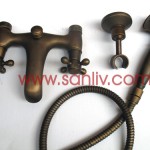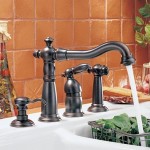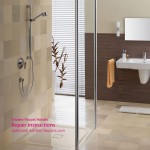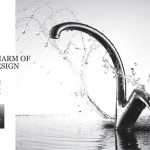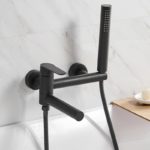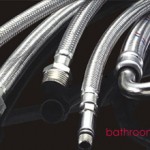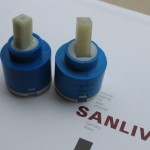Repair or Replace the faucet that won’t stop leaking with the help of the articles found in this section. With the detailed step-by-step guides, you’ll be able to install a new faucet in any of the room of your house. Now you can save both your time and money by saying goodbye to waiting around for high priced plumbers.
Em primeiro lugar, you need know the basics of your faucet. Read following tips and find out your fauct type, então, you will know how to repair your kitchen or bathroom faucet.
Cartridge-Type Faucet
- Also known as a washerless faucet.
- Uses a rubber diaphragm or two metal, plastic or ceramic discs with holes that align to let the water flow or close to shut off the water flow. Ceramic plates are more difficult to damage than rubber seats, but hard water can sometimes cause problems with the ceramic cartridges, such as squeaking or sticking.
- Single-handle faucets that use stainless steel ball design have just one moving part and are a durable alternative.
- Reduces leakage problems that result from worn washers.
- Easy to repair because most new models have the water-control mechanism housed in a replaceable cartridge.
- Replacing a cartridge is an easy do-it-yourself project, compared to working on conventional faucets. Most faucets that offer this convenience are labeled “self-contained cartridge.”
Ball-Type Faucet
- Also known as a washerless faucet.
- A single-handle faucet that uses a ball with openings in it to control hot and cold water.
- May leak either at the spigot or at the handle.
- Leaks from the handle are usually caused by improper adjusting-ring tension. To stop the leak, adjust the tension.
- Worn cam seals can also result in leaks at the handle.
- Worn spring-loaded, soft rubber seal assemblies usually cause dripping from the spigot.
Compression Faucet
- Also known as a washer-type or stem faucet.
- When the spindle is turned down, the washer or disk attached to its lower end is pressed tightly against a smoothly finished ring or ground-seat that surrounds the flow opening to shut off the water flow. If the washer and seat do not make a firm contact at all points, water will leak. This usually happens when the washer becomes worn.
- Seats in faucets that are not removable may be reground with reseating tools.
Disc-Type Faucet
- A washerless faucet.
- Water is controlled by openings in the two discs. When the discs are rotated to align, the water flows. When the discs are misaligned, the water shuts off.
- May have one or two handles. Fix by replacing the O-rings or, better yet, replace the whole disc.
Tub & Shower Faucet
- Usually combination style, where hot and cold mix in a single arm.
- Available in different patterns, they can be built into the wall or flush mounted on the wall above the bathtub.
- In three-valve bath and shower faucets, two valves control water and a third diverts water either through the spout or to the showerhead.
- Two-valve tub and shower faucets have an automatic device on the spout that, when activated, diverts water to the showerhead.
- Two-valve tub fillers and shower fittings fill either the tub or control water in the shower, as do the tub and shower faucets
Lavatory & Torneiras de Cozinha
- Often come in a combination style, where hot and cold mix in a single arm.
- Are available in several different patterns.
- A Ledge-Mounted faucet is mounted in a horizontal position.
- Standard lavatory faucets are made with 4″ centers.
- Wide Spread faucets (see image in next window) are made with adjustable center measurements up to 12″.
- The Wall-Mounted unit is connected to pipes coming through the wall above the sink. It is mounted vertically.
- The most common size in kitchen sink faucets is 8″ center, but 6″ and 4″ are also available.
- Concealed faucets are mounted underneath the sink, with only handle flanges and spout visible.
- Exposed faucets are mounted on top of the sink, with or without sprays.
- A mixing faucet, known generally as single lever, is produced by a number of manufacturers as swing spout kitchen faucets, lavatory faucets and bath faucets. They ordinarily operate by pushing the upright lever straight backward for a 50-50 opening of hot and cold water, back and to the right for cold, and back and to the left for hot water. They have the advantage of being quick-opening and closing, and nearly all have complete repair kits.
- An Over-The-Counter faucet is easier to install because there is no need to crawl under the sink and reach behind the basin to secure the faucet. It comes with factory-installed flexible supply lines and a spring-loaded toggle, with the screw head concealed by the escutcheon.
Laundry Faucet
- Mounts either on laundry tubs or on the wall above the tub. Most fiberglass tubs require a ledge faucet with 4″ centers.
- Sometimes furnished with a standard 3-3/4″ hose thread outlet on the spout. Most codes require the use of a vacuum breaker attachment if the outlet contains threads to prevent water contamination.
Sill Cock
- Is a faucet located on the outside wall of the house that easily hooks to garden hoses.
- The best type is a frost-proof sill cock, made of heavy red brass, that looks and works like any ordinary faucet. Contudo, water flow valves are located inside the building where it is warm.
- The anti-siphon frost-proof sill cock employs integral back-siphon and back-flow devices. These serve to prevent potential back-siphonage, qual, if unchecked, could compromise the safe potable water supply to the home. Hose-attached garden sprays and other pressurized canisters can potentially link a cross-connection if a pressure charge occurs when the frostproof is in the open position.
- The anti-siphon frostproof sillcock allows for outside spigot usage in freezing climates. The closing member (seat washer) is located inside the heated building.
Faucet Repair Tips
- When repairing a faucet, line the sink with a towel to keep tools from damaging the basin. This will also keep small parts from sliding down the drain

